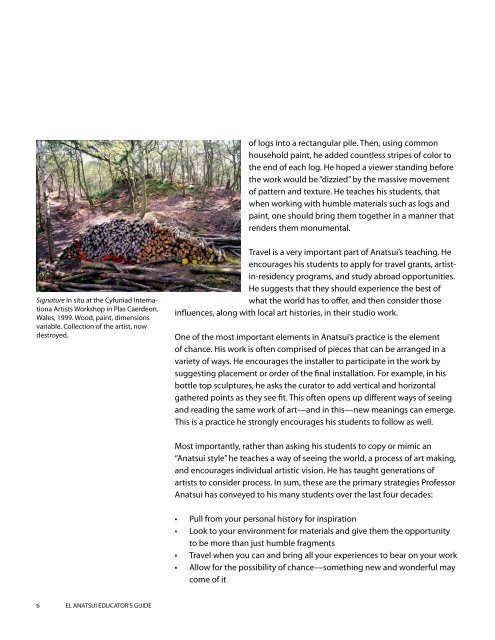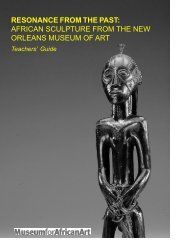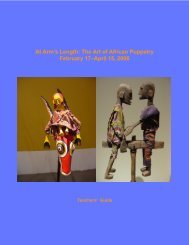El Anatsui
When I Last Wrote to You about Africa - Museum for African Art
When I Last Wrote to You about Africa - Museum for African Art
- No tags were found...
Create successful ePaper yourself
Turn your PDF publications into a flip-book with our unique Google optimized e-Paper software.
of logs into a rectangular pile. Then, using common<br />
household paint, he added countless stripes of color to<br />
the end of each log. He hoped a viewer standing before<br />
the work would be “dizzied” by the massive movement<br />
of pattern and texture. He teaches his students, that<br />
when working with humble materials such as logs and<br />
paint, one should bring them together in a manner that<br />
renders them monumental.<br />
Signature in situ at the Cyfuniad Internationa<br />
Artists Workshop in Plas Caerdeon,<br />
Wales, 1999. Wood, paint, dimensions<br />
variable. Collection of the artist, now<br />
destroyed.<br />
Travel is a very important part of <strong>Anatsui</strong>’s teaching. He<br />
encourages his students to apply for travel grants, artistin-residency<br />
programs, and study abroad opportunities.<br />
He suggests that they should experience the best of<br />
what the world has to offer, and then consider those<br />
influences, along with local art histories, in their studio work.<br />
One of the most important elements in <strong>Anatsui</strong>’s practice is the element<br />
of chance. His work is often comprised of pieces that can be arranged in a<br />
variety of ways. He encourages the installer to participate in the work by<br />
suggesting placement or order of the final installation. For example, in his<br />
bottle top sculptures, he asks the curator to add vertical and horizontal<br />
gathered points as they see fit. This often opens up different ways of seeing<br />
and reading the same work of art—and in this—new meanings can emerge.<br />
This is a practice he strongly encourages his students to follow as well.<br />
Most importantly, rather than asking his students to copy or mimic an<br />
“<strong>Anatsui</strong> style” he teaches a way of seeing the world, a process of art making,<br />
and encourages individual artistic vision. He has taught generations of<br />
artists to consider process. In sum, these are the primary strategies Professor<br />
<strong>Anatsui</strong> has conveyed to his many students over the last four decades:<br />
• Pull from your personal history for inspiration<br />
• Look to your environment for materials and give them the opportunity<br />
to be more than just humble fragments<br />
• Travel when you can and bring all your experiences to bear on your work<br />
• Allow for the possibility of chance—something new and wonderful may<br />
come of it<br />
6 EL ANATSUI EDUCATOR’S GUIDE





